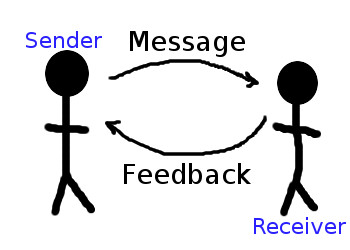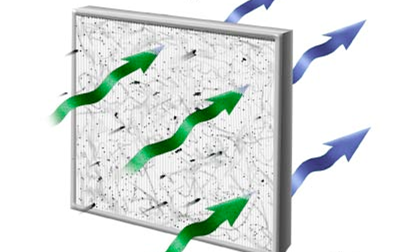"No one would talk much in society if they knew how often they misunderstood others."
-Johann Wolfgang Von Goethe
-Johann Wolfgang Von Goethe
Through my blog posts, I've been exploring things that I think are very important qualities that a manager or supervisor should exhibit. First, I looked at disorientating dilemmas and how they should be handled by managers or supervisors. In my second blog post, I explored organizational culture and why it is so important to organizations. In my last blog post, I explored conflict and how organizations should really handle it. I am continuing on my search of exactly what makes a fabulous manager or supervisor and now I am looking at communication. Communication within an organization is key. If an organization is not good at communicating with each other or with their customers, stakeholders, etc., they will not be successful and they will ultimately fail. Often times, managers do not communicate clearly with their employees and that leads to conflict!
Communication is the exchange and flow of information and ideas from one person to another; it involves a sender transmitting an idea, information, or feeling to a receiver (U.S. Army, 1983). Effective communication occurs only if the receiver understands the exact information or idea that the sender intended to transmit. Many of the problems that occur in an organization are either the direct result of people failing to communicate and/or process, which leads to confusion and can cause good plans to fail (Mistry, Jaggers, Lodge, Alton, Mericle, Frush, Meliones, 2008). Communication has 2 components: speaking and listening.
There are three phases in the communication process. The first phase, thought, is where information exists in the mind of the sender. This information can be a concept, idea, information or feelings. The second phase, encoding, occurs when a message is sent to a receiver in words or other symbols. The third and final phase in the communication process is decoding where the receiver translates the words or symbols into concepts or information that he or she can understand.
During the transmission of the message, two elements will be received by the receiver. The first element, context, is the actual words or symbols of the message that is known as language, the spoken and written words combined into phrases that make grammatical and semantic sense. Everyone interprets the meanings of words differently so even simple messages can be misunderstood. The second element, context, is the way the message is delivered and is known as paralanguage which is the nonverbal elements in speech such as the tone of voice, the look in the sender's eyes, body language, hand gestures, and the state of emotions (anger, fear, uncertainty, confidence, etc.) that can be detected. Although this element often causes messages to be misunderstood because we believe what we see more than what we hear, they are powerful communicators that help us to understand each other better.
Perhaps you've told someone to do something before and the person you told, the receiver, did not do what you asked them to do. You wonder why the receiver did not do what you wanted them to do. More than likely, the receiver misunderstood the message. A message has not been communicated unless it is understood (decoded) by the receiver. As the sender of a message, you do not know if the message has been sent unless you get communication or feedback from the receiver. This feedback tells the sender that the receiver understood the message, its level of importance and what must be done with it. Communication is an exchange, not just a give, as all parties must participate to complete the information exchange.
Now please watch a movie about the barriers of communication.
Communication is the exchange and flow of information and ideas from one person to another; it involves a sender transmitting an idea, information, or feeling to a receiver (U.S. Army, 1983). Effective communication occurs only if the receiver understands the exact information or idea that the sender intended to transmit. Many of the problems that occur in an organization are either the direct result of people failing to communicate and/or process, which leads to confusion and can cause good plans to fail (Mistry, Jaggers, Lodge, Alton, Mericle, Frush, Meliones, 2008). Communication has 2 components: speaking and listening.
There are three phases in the communication process. The first phase, thought, is where information exists in the mind of the sender. This information can be a concept, idea, information or feelings. The second phase, encoding, occurs when a message is sent to a receiver in words or other symbols. The third and final phase in the communication process is decoding where the receiver translates the words or symbols into concepts or information that he or she can understand.
During the transmission of the message, two elements will be received by the receiver. The first element, context, is the actual words or symbols of the message that is known as language, the spoken and written words combined into phrases that make grammatical and semantic sense. Everyone interprets the meanings of words differently so even simple messages can be misunderstood. The second element, context, is the way the message is delivered and is known as paralanguage which is the nonverbal elements in speech such as the tone of voice, the look in the sender's eyes, body language, hand gestures, and the state of emotions (anger, fear, uncertainty, confidence, etc.) that can be detected. Although this element often causes messages to be misunderstood because we believe what we see more than what we hear, they are powerful communicators that help us to understand each other better.
Perhaps you've told someone to do something before and the person you told, the receiver, did not do what you asked them to do. You wonder why the receiver did not do what you wanted them to do. More than likely, the receiver misunderstood the message. A message has not been communicated unless it is understood (decoded) by the receiver. As the sender of a message, you do not know if the message has been sent unless you get communication or feedback from the receiver. This feedback tells the sender that the receiver understood the message, its level of importance and what must be done with it. Communication is an exchange, not just a give, as all parties must participate to complete the information exchange.
Now please watch a movie about the barriers of communication.
Although talks about a few barriers to communication, anything that prevents understanding a message is a barrier. I will describe a few more barriers but they are many other physical and psychological barriers that exist.
Watch the below video clip from the movie Spanglish for an example of a barrier of communication! Although language is a primary barrier of communication here, do you see other examples of barriers? Perhaps smothering when Deborah doesn't give all the information to Flor. Do you think the environment that Flor is in is also a barrier to communication? Flor is still trying to get used to her surroundings and Deborah is continuously talking. Is perception another barrier? Watch the clip and try to apply the barriers of communication to this scene!
- Culture, background and bias: We allow our past experiences to change the meaning of the message. Our culture, background and bias can be good as they allow us to use our past experiences to understand something new, it is when they change the meaning of the message that they interfere with the communication process.
- Noise: Equipment and environmental noise impedes clear communication. The sender and the receiver must both be able to concentrate on the messages being sent to each other.
- Ourselves: Focusing on ourselves, rather than the other person can lead to confusion and conflict. Some of the factors that cause this are defensiveness, superiority and ego.
- Perception: If we feel the person is talking too fast, not fluently, does not articulate clearly, etc., we may dismiss the person. Also our preconceived attitudes affect our ability to listen. We listen uncritically to persons of high status and dismiss those of low status.
- Message: Distrations happen when we focus on the facts rather than the idea. Semantic distrations occur when a word is used differently than you prefer.
- Environmental: Bright lights, an attractive person, unusual sights or any other stimulus provides a potential distration.
- Smothering: We take it for granted that the impulse to send useful information is automatic. Too often we believe that certain information has no value to others or they are already aware of the facts.
- Stress: People do not see things the same way under stress. What we see and believe at a given moment is influenced by our psychological frames of references - our beliefs, values, knowledge, experiences and goals.
Watch the below video clip from the movie Spanglish for an example of a barrier of communication! Although language is a primary barrier of communication here, do you see other examples of barriers? Perhaps smothering when Deborah doesn't give all the information to Flor. Do you think the environment that Flor is in is also a barrier to communication? Flor is still trying to get used to her surroundings and Deborah is continuously talking. Is perception another barrier? Watch the clip and try to apply the barriers of communication to this scene!
Barriers to communication can be thought of as filters. The message leaves the sender, goes through the above filters and is then heard by the receiver. These filters may muffle the message. The way to overcome filters is through active listening and feedback!
Now I want to apply this information to a business setting. Below are a few tips to help you communicate better with people in your organization. You always have to remember that communication is a give and take relationship.
Communication is a huge topic of study and it's really hard to cover all you'd ever want to know about communication in one blog post. I have given you some great background information that you can hopefully take back to your organization to help you become a better communicator with all the stakeholders of the organization!
Check out my next post that wraps all the blogs up and gives you a preview of the my case study!
References
Clark, Donald. "Communication and Leadership." Leadership. Big Dog and Little Dog's Bowl of Biscuits, 22 May 2010. Web. 07 May 2012. <http://www.nwlink.com/~donclark/leader/leadcom.html>.
Menck, Jessica Claire. "Week 5, Lesson A Lecture Notes." 13 Feb. 2012. Lecture.
- When speaking or trying to explain something, ask the listeners if they are following you.
- Ensure the receiver has a chance to comment or ask questions.
- Try to put yourself in the other person's shoes - consider the feelings of the receiver.
- Be clear about what you say.
- Look at the receiver.
- Make sure your words match your tone and body language (nonverbal behaviors).
- Vary your tone and pace.
- Do not be vague, but on the other hand, do not complicate what you are saying with too much detail.
- Do not ignore signs of confusion.
Communication is a huge topic of study and it's really hard to cover all you'd ever want to know about communication in one blog post. I have given you some great background information that you can hopefully take back to your organization to help you become a better communicator with all the stakeholders of the organization!
Check out my next post that wraps all the blogs up and gives you a preview of the my case study!
References
Clark, Donald. "Communication and Leadership." Leadership. Big Dog and Little Dog's Bowl of Biscuits, 22 May 2010. Web. 07 May 2012. <http://www.nwlink.com/~donclark/leader/leadcom.html>.
Menck, Jessica Claire. "Week 5, Lesson A Lecture Notes." 13 Feb. 2012. Lecture.



 RSS Feed
RSS Feed